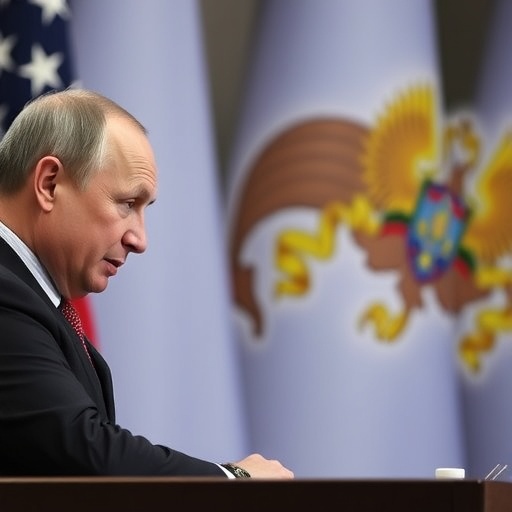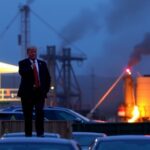Putin Defies US Sanctions Pressure: Admits Deep Economic Wounds for Russia Amid Ukraine Standoff
In a bold address that echoed through the halls of the Kremlin, Russian President Vladimir Putin on Tuesday dismissed mounting pressure from the United States, vowing never to yield to American demands even as he candidly admitted that fresh US sanctions could inflict severe damage on the Russian economy. This stark admission comes at a precarious moment, with tensions over Ukraine simmering and whispers of former President Donald Trump’s influence lingering in international diplomacy.
- Putin’s Kremlin Address: A Blend of Defiance and Economic Caution
- Unpacking the Latest US Sanctions: Targets and Immediate Ripples
- Russia’s Economic Vulnerabilities Exposed: From Energy to Everyday Life
- Ukraine Conflict Fuels Sanctions Fire: Trump’s Shadow Looms Large
- Global Echoes and Russia’s Path Forward: Adaptation or Isolation?
Putin‘s words, delivered during a state meeting in Moscow, underscore a resilient yet vulnerable stance: “We will not bow to the dictates of Washington,” he declared, his voice firm amid applause from assembled officials. Yet, in a rare moment of transparency, the long-serving leader acknowledged, “These measures will undoubtedly cause pain to our economy, but the Russian people have endured far worse.” This duality—defiance paired with realism—has sent ripples through global markets, highlighting the precarious balance Russia maintains in the face of escalating geopolitical strife.
The announcement arrives just days after the US imposed a new round of sanctions targeting key Russian financial institutions, energy giants, and oligarchs linked to the ongoing conflict in Ukraine. These penalties, building on measures initiated during the Trump administration and intensified under President Joe Biden, aim to curb Russia’s military capabilities and economic resilience. As Putin navigates this pressure, questions swirl about the long-term viability of Russia’s economy and its implications for the broader Ukraine crisis.
Putin’s Kremlin Address: A Blend of Defiance and Economic Caution
Standing before a backdrop of Russian flags in the Kremlin’s grand Andreyevsky Hall, Putin painted a picture of national fortitude against what he termed “imperialist aggression.” His speech, lasting over an hour, delved into historical parallels, invoking the Soviet Union’s endurance during World War II to rally domestic support. “Just as our forebears withstood the Nazi siege, we shall weather this storm imposed by the West,” Putin stated, his tone measured but unyielding.
Yet, the address took an unexpected turn when Putin addressed the economic fallout directly. Citing internal projections, he revealed that the new US sanctions could shave up to 2.5% off Russia’s GDP growth in the coming year, exacerbating inflation rates that have already climbed to 7.4% in recent months. This admission marks a departure from Putin’s earlier rhetoric, which often downplayed sanctions’ impact as mere “Western fantasies.” Analysts suggest this candor stems from mounting domestic pressures, including supply chain disruptions and a ruble that has fluctuated wildly since the Ukraine invasion began in February 2022.
Putin’s reference to Ukraine was pointed, framing the sanctions as a punitive response to Russia’s “special military operation.” He accused the US of using economic warfare to prop up what he called a “failing Ukrainian regime,” tying the economic narrative directly to the battlefield dynamics. This linkage not only justifies Russia’s position but also serves as a call to arms for his supporters, emphasizing sovereignty over submission.
Unpacking the Latest US Sanctions: Targets and Immediate Ripples
The US Treasury Department’s latest sanctions package, unveiled last week, zeroes in on over 300 entities and individuals, including major banks like Sberbank and energy behemoths such as Gazprom. These measures expand on previous restrictions, prohibiting US firms from engaging in transactions with sanctioned Russian counterparts and freezing assets held in American jurisdictions. The goal, according to a White House statement, is to “starve Russia’s war machine” by limiting access to critical technologies and foreign capital.
Statistics paint a grim picture for the Russian economy: Since the full-scale invasion of Ukraine, Western sanctions have frozen approximately $300 billion in Russian central bank reserves abroad, forcing Moscow to pivot toward alternative currencies like the Chinese yuan and Indian rupee. Trade data from the International Monetary Fund indicates that Russia’s exports to Europe have plummeted by 40%, with oil and gas revenues—once comprising 60% of the federal budget—now rerouted through shadowy “ghost fleets” to evade enforcement.
One particularly stinging provision targets Russia’s aluminum and steel sectors, vital for military production. Alcoa and other US suppliers have severed ties, leading to projected shortages that could delay infrastructure projects and military logistics. As Putin noted in his speech, “These sanctions are not just economic; they are an assault on our industrial heartland.” The immediate market reaction was swift: Russia’s RTS Index dipped 3.2% in trading sessions following the announcement, while global commodity prices for nickel—Russia’s forte—surged amid supply fears.
- Key Sanctioned Entities: Sberbank (Russia’s largest lender), Rosneft (oil major), and several tech firms accused of aiding cyber operations.
- Broader Impact: Secondary sanctions threaten third-party countries, potentially isolating Russia further in global trade networks.
- Enforcement Challenges: Despite loopholes, US officials report a 70% compliance rate among international banks, up from 50% in 2022.
This escalation recalls the sanction regimes of the Trump era, when initial responses to Russia’s election meddling and Ukraine annexations laid the groundwork for today’s broader conflict. Trump’s own comments last month, suggesting he’d end the Ukraine war “in 24 hours,” have fueled speculation about potential policy shifts if he returns to power, adding layers of uncertainty to Putin’s calculations.
Russia’s Economic Vulnerabilities Exposed: From Energy to Everyday Life
Beneath Putin’s resolute exterior lies an economy teetering on the edge. The Russian economy, once buoyed by high oil prices, now grapples with multifaceted challenges amplified by US sanctions. Inflation has eroded purchasing power, with food prices rising 12% year-over-year, according to Rosstat data. Ordinary Russians feel the pinch: A recent Levada Center poll shows 45% of citizens reporting financial hardships, a sharp increase from pre-invasion levels.
The energy sector, Russia’s economic lifeline, bears the brunt. Sanctions have slashed pipeline exports to Europe by 90%, compelling Moscow to discount Urals crude to Asian buyers at $10-15 below Brent benchmarks. This has translated to a $50 billion revenue shortfall in 2023 alone, per estimates from the Oxford Institute for Energy Studies. Putin addressed this in his speech, promising state subsidies to shield households from utility bill hikes, but experts warn of strained budgets amid military spending that now exceeds 6% of GDP.
Beyond energy, the tech and manufacturing realms suffer. US export controls on semiconductors have halted production lines at companies like Yandex, forcing reliance on subpar Chinese alternatives. Unemployment hovers at 3%, but underemployment in sanctioned industries masks deeper woes. “The Russian economy is in a war footing, resilient but fatigued,” noted Elena Ivanova, an economist at the Higher School of Economics in Moscow. Her analysis aligns with Putin’s admission, suggesting that while diversification efforts—such as BRICS partnerships—offer hope, short-term pain is inevitable.
The human element adds emotional weight: Stories from Siberian factories to Moscow apartments highlight families rationing heat during harsh winters. Putin’s nod to this suffering, rare for a leader known for ironclad control, may aim to preempt unrest, drawing parallels to the 1998 financial crisis that nearly toppled his predecessor.
Ukraine Conflict Fuels Sanctions Fire: Trump’s Shadow Looms Large
At the heart of this sanctions saga is the protracted war in Ukraine, now entering its third year with no end in sight. US sanctions are explicitly tied to Russia’s advances in Donbas and Kherson, where recent escalations have drawn international condemnation. Kyiv’s President Volodymyr Zelenskyy praised the measures as “a vital step toward justice,” during a virtual UN address, emphasizing how they disrupt Moscow’s supply chains for drones and artillery.
Putin, in turn, lambasted the sanctions as “collective punishment” for defending Russian-speaking populations in Ukraine. His narrative frames the conflict as existential, rejecting US pressure as interference in sovereign affairs. This rhetoric resonates domestically but isolates Russia globally, with NATO allies like Germany and the UK mirroring US actions by blacklisting additional Russian assets.
Enter Donald Trump, whose name evokes both nostalgia and trepidation in Kremlin circles. During his presidency, Trump imposed initial sanctions following the 2018 Skripal poisoning and withheld military aid to Ukraine amid impeachment scrutiny. Recent polls show Trump leading in US Republican primaries, with promises to negotiate directly with Putin. “If Trump wins, sanctions might ease, but at what cost to Ukraine?” pondered foreign policy expert Fiona Hill in a recent op-ed. Putin’s speech subtly referenced this, warning that “American elections change nothing about our resolve,” yet analysts detect underlying hope for a Trump-led thaw.
- Historical Sanctions Timeline: 2014 Crimea annexation sparks first wave; 2022 invasion multiplies restrictions tenfold.
- Ukraine’s Stake: Sanctions have slowed Russian troop movements by 20%, per Pentagon reports.
- Trump Factor: His 2019 Ukraine call highlighted tensions; current rhetoric suggests deal-making potential.
This interplay of sanctions, war, and politics underscores the high stakes, with Putin’s admission signaling a pragmatic pivot amid unyielding ideology.
Global Echoes and Russia’s Path Forward: Adaptation or Isolation?
Putin’s defiance has elicited varied global responses. China, Russia’s staunchest ally, pledged increased trade ties, with bilateral volumes hitting $240 billion in 2023—up 26% from the prior year. Beijing’s state media echoed Putin’s sentiments, criticizing US “hegemony,” while quietly benefiting from discounted Russian energy. In contrast, the European Union announced parallel sanctions on Wednesday, targeting luxury goods imports to squeeze elite wallets.
Emerging markets like India and Turkey walk a tightrope, purchasing Russian oil while urging de-escalation in Ukraine. “Sanctions are a double-edged sword,” said Turkish Foreign Minister Hakan Fidan in Ankara, highlighting how they inflate global energy prices and disrupt supply chains. The World Bank forecasts Russia’s growth at a modest 1.1% for 2024, down from 3.6% in 2023, attributing the slowdown to sanction-induced isolation.
Looking ahead, Putin’s strategy hinges on internal reforms and alliances. He outlined plans for a “sovereign internet” and ruble-based trade settlements to bypass SWIFT exclusions. Military production ramps up, with domestic drone output doubling since 2022. Yet, challenges persist: Brain drain accelerates, with 1.2 million skilled workers emigrating post-invasion, per UN estimates. If US sanctions tighten under Biden—or loosen under a hypothetical Trump administration—Russia’s trajectory could shift dramatically.
For Ukraine, sustained pressure offers leverage in peace talks, potentially forcing concessions on territorial claims. Globally, the saga tests multilateralism, with implications for future conflicts from Taiwan to the Middle East. As Putin concluded his address, “Our economy may bend, but it will not break.” Whether this proves prophetic or perilous remains the pivotal question in this unfolding drama.








